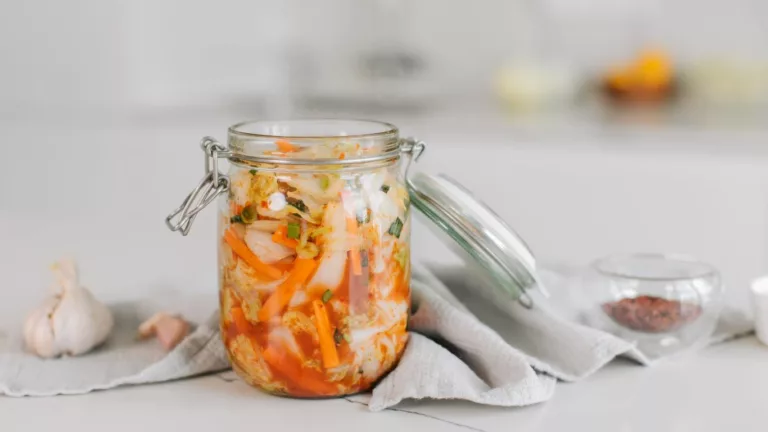GERD-Safe Smoothie Bowls That Soothe Acid Reflux Naturally
If you’re anything like me, mornings can be chaotic. Between emails, school drop-offs, and trying to stay awake without coffee (which is a huge trigger for my reflux), I used to just grab whatever was easy—usually toast or cereal. But after years of battling GERD and experimenting with countless diets, I finally found a breakfast that’s not only gentle on my stomach but also tastes like dessert: smoothie bowls. And no, not the super acidic ones you find in trendy cafes loaded with citrus and yogurt. I’m talking about low-acid, fiber-rich, creamy bowls that actually soothe rather than ignite your reflux.
Why Smoothie Bowls Can Be GERD-Friendly (If Done Right)

For people with GERD, finding foods that are satisfying yet safe can feel like an impossible juggling act. Smoothie bowls seem innocent, but many recipes are sneakily acidic—packed with pineapples, citrus, or even yogurt that can fire up symptoms. When done correctly, though, these bowls become a nutrient-dense, soothing option that supports digestion and doesn’t leave you reaching for antacids.
The Science Behind It
Low-acid ingredients like oats, almond milk, bananas, and chia seeds are rich in fiber, which may help ease reflux symptoms by supporting gut motility and reducing pressure on the lower esophageal sphincter (LES). According to Mayo Clinic, managing dietary triggers is a first-line approach in GERD management, and fiber plays a key role.
Key Ingredients for a GERD-Safe Smoothie Bowl

1. Base Liquids
- Unsweetened Almond Milk: A neutral, low-acid choice that’s gentle on digestion.
- Oat Milk: Creamy and satisfying, it’s perfect for a thicker consistency without the acid hit.
- Rice Milk: Naturally sweet and GERD-safe in moderate quantities.
2. Fruits That Won’t Fight Back
You’ll want to avoid pineapples, oranges, strawberries, and even apples (yes, even those can be acidic depending on the type). Here’s what works:
- Bananas: Classic reflux-soother and my personal go-to.
- Papaya: Gentle on the stomach and supports digestion with natural enzymes. Learn more about its benefits here.
- Mango (in moderation): Non-citrus, lower-acid, and adds tropical flair.
- Avocado: Technically a fruit, and an amazing source of healthy fats that help calm acid flare-ups. Plus, it keeps you full longer.
3. Fiber and Protein Boosters
- Rolled Oats: Blend them in or use them as a topper for a GERD-friendly fiber boost.
- Chia Seeds: Soaked chia adds texture and fiber without irritating your esophagus.
- Nut Butters (like almond butter): Avoid peanut butter, which can trigger symptoms for some. Use smooth, natural almond butter in small amounts.
4. Optional Soothing Extras
- Slippery Elm Powder: Has mucilage properties that coat the esophagus and may reduce irritation. More on it here.
- Alkaline Protein Powder: If you’re using a protein supplement, choose a clean, alkaline one without whey or artificial sweeteners.
Common Smoothie Bowl Pitfalls to Avoid

Watch for Hidden Triggers
- Greek yogurt: High in protein, yes—but also acidic and often aggravates reflux.
- Citrus fruits: Even a squeeze of orange juice can undo a good bowl.
- Chocolate protein powders: Caffeine + cocoa = disaster for GERD.
Overloading the Bowl
Even if your ingredients are safe, piling on too much can stretch your stomach and lead to pressure on the LES. Keep your portions moderate and consistent.
Temperature Matters
Super cold foods can tighten the LES temporarily. I usually let my smoothie bowl sit for 5 minutes before eating—just enough to soften but not melt it. Sounds minor, but trust me, it makes a difference.
Why These Bowls Work for Me (and Might Work for You Too)

I’ve been through the full spectrum of GERD symptoms—burning throat, chest tightness, the whole package. What I didn’t realize early on was that breakfast played a bigger role than I thought. Swapping out my old go-to meals for a calming smoothie bowl helped stabilize my mornings. I still get flare-ups occasionally (especially after stressful days), but having a go-to that doesn’t cause chaos in my gut makes a world of difference.
If you’re looking for more strategies on how to manage your symptoms naturally, this guide on natural remedies for GERD is a must-read.
And if you’re still in the early stages of trying to figure out what foods hurt vs help, start with this detailed overview of GERD-friendly diets.
My Go-To GERD-Safe Smoothie Bowl Recipes

Let’s get to the good stuff—actual recipes. These are not the usual Pinterest-perfect bowls that’ll leave you curled up with a burning chest an hour later. These are ones I’ve personally tested during reflux flare-ups, stressful mornings, even post-vacation stomach drama. Each one is simple, satisfying, and designed to keep your digestive system calm.
1. Creamy Banana-Oat Smoothie Bowl
This one is my ultimate fallback recipe—bland in the best way, creamy, filling, and zero burn.
- 1 ripe banana (fresh, not frozen)
- 1/4 cup rolled oats (pre-soaked in water for 10 minutes)
- 3/4 cup unsweetened oat milk
- 1 tsp almond butter (smooth, no additives)
- 1/4 tsp cinnamon (optional – only if you tolerate it)
Toppings: Thin banana slices, soaked chia seeds, shredded coconut (unsweetened)
Why it works: The oats help with satiety, banana calms the gut, and almond butter adds creaminess without triggering acid.
2. Papaya Chia Digestive Bowl

Papaya contains papain, a digestive enzyme that may help ease bloating and aid protein digestion. According to a study published in the Journal of Medicinal Food, papaya supplementation showed promise in relieving symptoms of functional dyspepsia, including bloating and discomfort.
- 1 cup ripe papaya (peeled and cubed)
- 1/2 frozen banana
- 1/2 cup rice milk
- 1 tbsp soaked chia seeds
- 1/4 avocado (adds healthy fats and creaminess)
Toppings: Soft oats, coconut flakes, hemp hearts
More on papaya’s benefits for reflux: Is Papaya Good for Acid Reflux?
3. Gentle Mango Avocado Bowl
Perfect for warmer days when you want something light, but not acidic.
- 1/2 ripe mango (not too fibrous)
- 1/4 avocado
- 1/2 banana
- 1/2 cup unsweetened almond milk
- 1 tsp ground flaxseed
Toppings: Oat flakes, sliced mango, puffed quinoa
Pro tip: Use slightly overripe mangoes—they’re gentler on your gut.
Tips to Customize Your GERD-Safe Bowl

1. Watch the Texture
If you’re dealing with a sore esophagus, skip the crunchy granola. Stick to soaked toppings, like chia, oats, or soft fruit slices.
2. Go Easy on Fats
Healthy fats like avocado and almond butter are great in moderation. Too much, and you risk delayed gastric emptying—hello, reflux.
3. Use Natural Sweetness
Skip honey, dates, or maple syrup. Ripe bananas and papaya provide all the sweetness you need. If you must sweeten, a small drizzle of GERD-safe honey works for some folks, but test cautiously.
4. Meal Prep Smart
You can pre-cut fruits and portion them into freezer bags for quick blending. Don’t fully prep and store blended smoothie bowls, though—they oxidize and lose texture fast. Fresh is best when dealing with reflux.
Best Times to Eat Your Smoothie Bowl

Mornings: This is the most reflux-friendly time, as your stomach is empty and upright posture helps digestion. Smoothie bowls digest easily and won’t weigh you down.
Light Dinner: Believe it or not, I’ve had these for dinner when I feel heavy or bloated. If you’re within 3 hours of bedtime, keep it small and skip toppings altogether. Pair it with tips from this guide on GERD-safe bedtime routines for nighttime reflux prevention.
What to Pair With Your Smoothie Bowl

- Warm water or herbal tea (like chamomile) helps ease digestion and keeps you hydrated.
- A handful of low-acid nuts like soaked almonds if you need extra calories (skip if you’re sensitive to nuts).
- Low-acid toast with a thin spread of almond butter if you’re really hungry—just keep it simple.
Beyond Breakfast: Smoothie Bowls as Digestive Therapy
When my GERD flares up, I often skip heavy meals for a day or two and rely on these bowls. They’re nourishing but light, and they keep my gut happy without overwhelming it. You’d be surprised how calming the right food can feel when your esophagus is inflamed and irritated.
If you’re trying to figure out whether you’re dealing with typical reflux or something more serious, you might want to check this article on GERD symptoms you shouldn’t ignore.
Low-Acid Protein Additions for Your Smoothie Bowl

Protein is essential, but traditional sources like whey, Greek yogurt, or even some nut-based powders can trigger acid reflux. Through my own trial-and-error (and a few awful nights), I’ve figured out what actually works.
GERD-Safe Protein Options:
- Pea protein isolate – A clean, neutral choice with minimal acidity. Look for unflavored and unsweetened versions.
- Hemp protein – Earthy in taste, but works well in tropical-style bowls with mango or papaya.
- Silken tofu – Blendable and high in protein, tofu is surprisingly gentle on most GERD stomachs. See this guide on tofu’s safety for GERD.
What to Avoid:
- Whey protein concentrate or isolate (often triggers bloating and reflux)
- Soy protein (can be harsh unless you tolerate soy very well)
- Artificially flavored or sweetened blends
If you’re unsure, start with ½ serving of a new protein, blend it into a mild base, and monitor how your body reacts. GERD-friendly eating is part science, part self-experiment.
Expert Tips to Elevate Your GERD-Safe Bowl Game

I’ve worked with a registered dietitian in the past to manage my symptoms, and I asked her what most people with GERD overlook when building healthy bowls. Here’s what she shared:
- Stick to low-glycemic fruits like papaya, berries (if tolerated), and bananas. Blood sugar spikes may correlate with reflux events in sensitive individuals.
- Watch food temperature: Blending frozen ingredients is fine, but avoid eating them icy cold. Let the smoothie sit 5–10 minutes to warm slightly.
- Skip powdered greens: Many “superfood” greens powders are acidic or contain irritants. Instead, steam and cool real spinach if you want to sneak in veggies.
Frequently Asked Questions (FAQ)
Can I use frozen bananas or papaya?
Yes, but let them thaw a few minutes before blending to reduce the temperature shock on your stomach.
Are acai bowls GERD-safe?
Typically no. Acai is more acidic than most low-acid fruits. If you love the texture, try using purple sweet potato for color and creaminess instead.
Is coconut milk okay?
In small amounts, yes. But it’s high in fat, which can relax the lower esophageal sphincter. If you use it, dilute it with water or mix with almond milk.
How do I meal prep bowls for the week?
Prep your ingredients, portion them into freezer-safe bags, and label them by flavor profile. Avoid blending ahead of time—smoothies lose texture and can develop off-putting flavors if stored too long.
Can I eat smoothie bowls every day?
Absolutely, as long as you rotate ingredients to get nutritional variety and listen to your body’s cues. For days when your reflux is acting up, go even simpler: oats + banana + oat milk, and skip toppings.
Signs Your Bowl Is Too Harsh for GERD

Even a “healthy” bowl can turn your stomach upside-down if it includes hidden triggers. If you notice:
- Throat irritation within 15–30 minutes
- Burping or tight chest shortly after eating
- Nausea or a bloated feeling
…then it’s time to adjust. Swap acidic fruits, remove protein powders, or reduce volume. Less is more when healing your gut lining.
Real-Life Reflection: How These Bowls Changed My Gut Health
Before I found the right balance of ingredients, breakfast was hit or miss—sometimes I’d skip it entirely just to avoid discomfort. But once I nailed down my go-to GERD-safe smoothie bowl rotation, everything changed. My morning energy improved. I wasn’t popping antacids like candy. And the best part? It became a little ritual I actually looked forward to.
Food doesn’t have to be the enemy when you have GERD. With the right ingredients and a little personal experimentation, it can be your ally.
And if you want to go deeper into managing your reflux through long-term dietary and lifestyle adjustments, check out the GERD Diet Plan That Actually Works. It covers the broader framework for soothing your digestive system naturally, from breakfast through bedtime.

Camellia Wulansari is a dedicated Medical Assistant at a local clinic and a passionate health writer at Healthusias.com. With years of hands-on experience in patient care and a deep interest in preventive medicine, she bridges the gap between clinical knowledge and accessible health information. Camellia specializes in writing about digestive health, chronic conditions like GERD and hypertension, respiratory issues, and autoimmune diseases, aiming to empower readers with practical, easy-to-understand insights. When she’s not assisting patients or writing, you’ll find her enjoying quiet mornings with coffee and a medical journal in hand—or jamming to her favorite metal band, Lamb of God.






